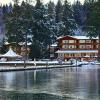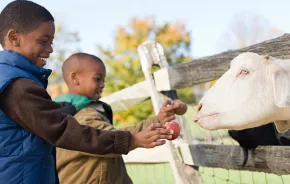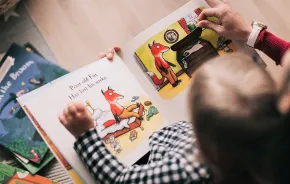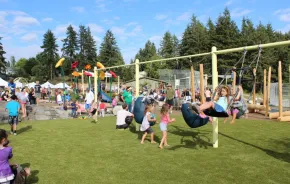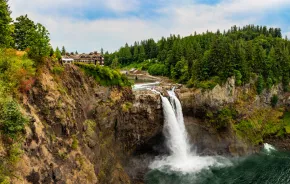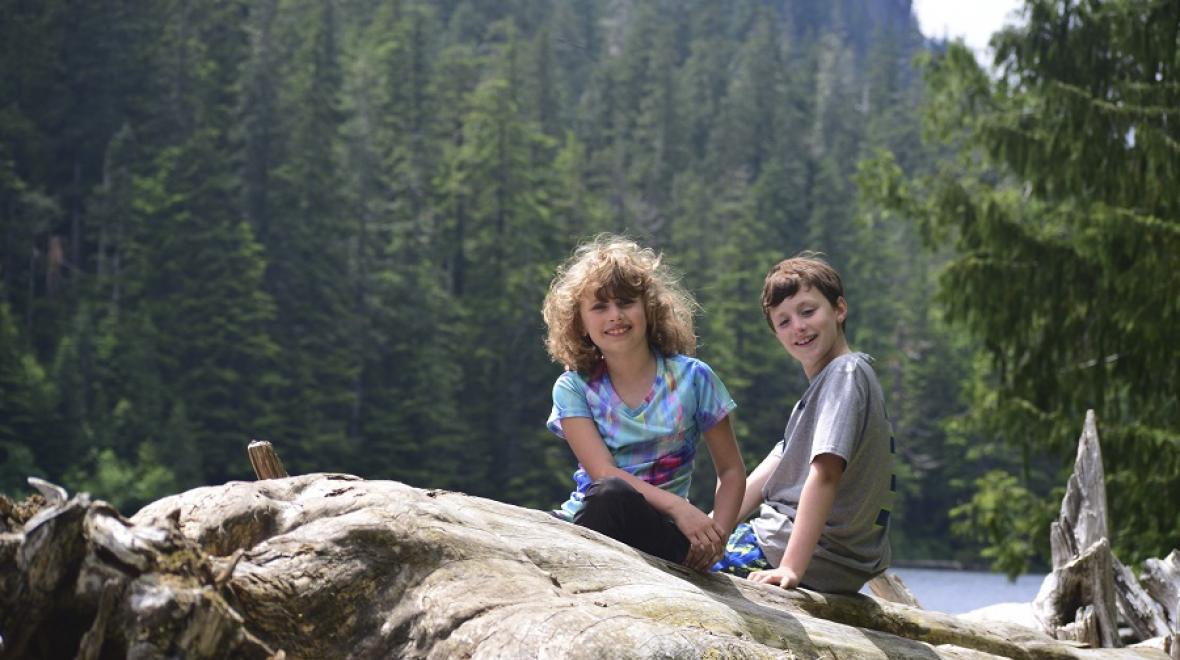
Photo:
The author's two children pose for a photo near Barclay Lake; Credit: Susan Elderkin
By Elisa Murray and Linnea Westerlind
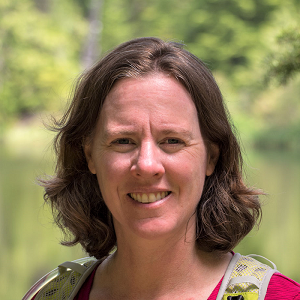
Susan Elderkin is the author of “Best Hikes With Kids: Western Washington,” published in 2018 by Mountaineers Books. But the book almost didn’t happen, because, as Elderkin puts it, “My kids weren’t the best hikers.”
“The last hike we had taken before I was asked to do this was a complete and utter flop,” she recalls. “They literally asked me if we were done with the hike 100 yards in, when we could still see the car.”
On that day, Elderkin cut her losses. It was cold and rainy, so she let her son and daughter, then ages 5 and 8, eat their fill of the wild blueberries that were in abundance near the trailhead, and then they headed home. But when she revisited the subject with her kids a few weeks later — because if she was going to write a guidebook on family hiking, she needed a family that actually hiked — they surprised her by encouraging her to do it and agreeing to help. The project was a go.
Over the next two years, Elderkin hit the trail hundreds of times, often with her family in tow, on a mission to rewrite the definitive guide to hiking as a family in western Washington.
Along the way, she learned some essential strategies for engaging kids in hiking, when to back off and why finding the perfect post-hiking treat for your family is essential. With hiking season now in full swing, we asked her to share some of her hard-won wisdom.
Why do you feel that hiking and outdoor experiences are important for families?
The connection to nature is important, perhaps even more so than when we were kids, because kids today are so connected to their technology. Hiking is a way kids can really disconnect and interact with the nature around them. It’s great exercise, but it’s also a way to meditate and be in a peaceful place. Kids are inheriting this earth, and by having connections to nature as children, it’s going to make it easier for them to connect as adults and be good stewards of it.
Can you share some tips or strategies for getting kids to enjoy hiking, or even just being outside in general?
First, choose the right trail, considering your kids’ stamina and their interests. One of the things I tried to do in the book is to pull out what to expect on each trail, whether you’re going to see big trees or waterfalls or wildlife.
Second, set expectations. This one is key. Every time I’ve hiked with my kids and it’s gone sideways, it’s because I’ve forgotten to set expectations, or I’ve changed them at the last minute. So, I tell them where we’re going. I tell them what it’s going to be like: Is it going to be a lot of up and down? Are you going to see a river? How long is the hike? What are we going to do afterward?
Another tip is to bring a friend along — this can be a game changer. The kids complain less if they have someone to talk to and they stay occupied.
You also want to make sure you’re dressing for success and bringing extra layers of clothing and rain gear — especially extra socks, because kids always like to plunge their feet in water!
Bring lots of snacks: We often take multiple snack breaks instead of a lunch because their metabolism is so much faster. It’s also really important to make sure they drink enough water. Kids often don’t understand that they’re thirsty.
On the trail, you can play games like I spy or a scavenger hunt. Walkie-talkies are always a big hit. With my daughter, we make up a story together as we walk.
Do you have any strategies for encouraging tweens and teens to enjoy hiking?
The biggest thing is to involve them in the planning and the prep, so that they become invested. Pull out the maps, hand them the guidebook and ask them to choose a hike that they want to do.
Otherwise, it’s many of the same strategies that you use for younger kids: setting expectations, inviting friends, promising that you’re going to stop for ice cream afterwards. In our family, we have a tradition of stopping at a Dairy Queen whenever we see one, which makes for a motivational after-hiking treat.
What have you learned about what types of hikes kids enjoy most?
I suggest hikes in the book that tap into children’s sense of wonder. You can climb small mountain peaks with kids, and there’s a big sense of accomplishment. A couple of easy summits are Red Top Lookout and Sugarloaf Mountain. If you have kids who love water, hikes with a swimming hole or waterfall are a great draw. Barclay Lake or Franklin Falls are good choices, especially midweek, when they are less crowded. Hikes with big old-growth trees can be really appealing, like Boulder River or the Asahel Curtis Nature Trail.
My kids also love berries, so any time that they can eat and forage along the trail, they like that. Our favorite August berry patch is at Hyas Lake. We also like weird geography, and Beacon Rock on the Columbia River really ticks that box.
What are a couple of things that are always in your backpack, in addition to the 10 essentials?
So of course, the 10 essentials. For every hike, I always have extra clothes, food, water and sunscreen. I keep a first aid kit in my pack at all times, because you never know when someone is going to stumble and fall. I keep a knife, insect repellent, a flashlight and, for hikes that are longer than a mile or two, a map.
Another thing I always have is a trowel, a little bit of toilet paper and a plastic bag for when nature calls. A whistle is a good idea, especially if your kid likes to run up ahead of you on the trail. Have a whistle around your child’s neck and make sure they know how to use it.
There are also some fun extras. If you’re going to make a day out of it, bring along a portable hammock. And if you’re going to a beach, bring a bucket and a shovel so they can dig and make sandcastles.
You have a ritual of camping and hiking with each of your kids individually every summer. How did that start and why has it made a difference in your family?
When I was researching the book, I started a tradition of taking one of my children for three or four nights on a camping trip each summer. We would choose a place that I needed to research, and we would do all the nearby hikes. It was really rewarding to explore different areas with them.
We’ve continued that tradition every summer. My son is now 15. Last summer he was like, “Oh, I don’t want to go. That doesn’t sound fun. I can’t be away from my Xbox.” And I said, “Well, I’m sorry, it’s a tradition. Where do you want to go? Help me plan this.”
We ended up visiting the Olympic Peninsula and pitching a tent at Deer Park, which is this amazing campground way up high. And he had a great time.
In 2020, my daughter and I revisited the first trip we did together, in the Icicle Creek area near Leavenworth. We hiked the same hikes, including the one that she thought was super hard when she was 6. Now she said, “That was easy!” It was this nice little connection back to her younger self.
How has hiking with children made a difference to you?
One of the things that I found really rewarding about hiking when the kids were young was slowing down and really appreciating the journey and not just the destination. Now that they’re older, I simply cherish that time outside, unplugged and in our beautiful corner of the world.
You can buy a copy of “Best Hikes With Kids: Western Washington” from the Mountaineers website, Amazon or your favorite independent bookstore.





